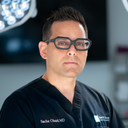Your scar can be lowered so it is hidden beneath your panty- line and also at the junction of your pubic hair bearing area. Regarding the potential for a red raised scar please note the following advice that I recommend to my patient in these circumstances:








